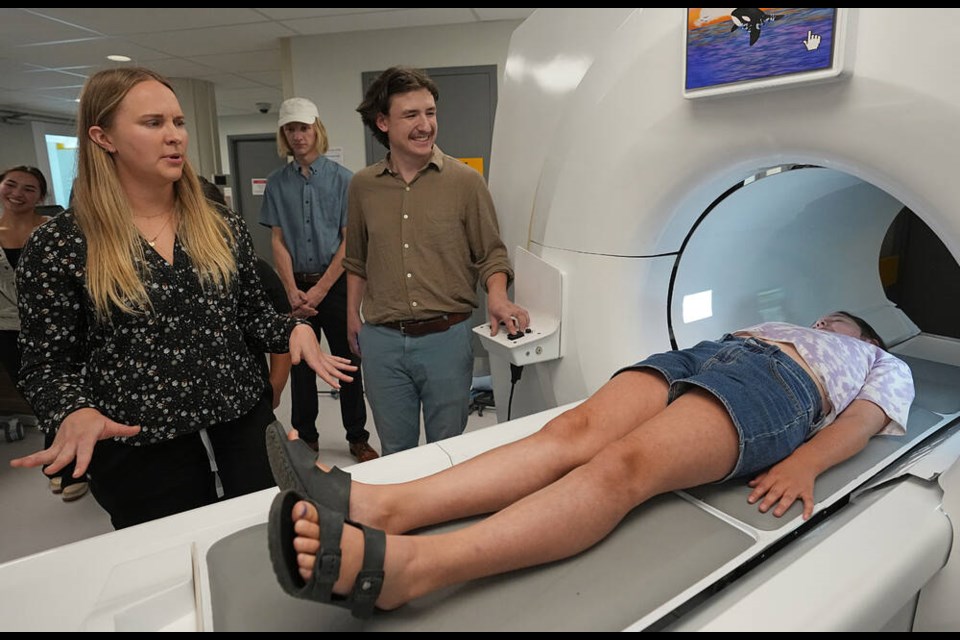Spaceship. Washing machine. Doughnut.
Becki Steel has heard all of those and more when she asks pediatric patients at Victoria General Hospital what a magnetic-resonance imaging machine looks like.
She said the device can be intimidating for children who are due for an MRI procedure, so she put out the idea of a simulator to the Camosun College engineering department in the hope it could help young people get used to the machine and what it does.
“My job in the hospital is to make things like this less scary,” said Steel, child-life practice lead at Victoria General.
She said it’s understandable that children would be hesitant about a device where they have to go into a big cylinder that makes loud noises “like your refrigerator is broken. Even for an adult, it can be a really overwhelming experience.”
Five Camosun students and instructor Jeffrey Stephen took on the project. Three-and-a-half months and about 5,000 hours of effort later, the Camosun students unveiled their creation at a gathering in the pediatric department this week — a model that looks, sounds and operates like the real thing.
Funding of $26,000 came from Seattle-based Child’s Play Charity, which supports hospitals around the world and has donated over $200,000 to the Victoria General child-life initiative since 2009. Other donations came in as well.
Stephen, who leads the “capstone” projects that mechanical-engineering students take on to culminate their studies, said the MRI-simulator project was a huge challenge.
“The students have been fantastic and this really is a story about their commitment, about their persistence.”
While some other hospitals have similar devices, the students had to come up with something that could be taken apart and stored, and that fit into the limited confines of the Victoria General pediatric ward.
“We had to make something that never existed, and we didn’t know how,” Stephen said.
What they made has an outer shell fashioned from fiberglass, chosen in part because it can be sanitized — as per the requirements for infection control — and there is a padded surface that moves in and out of the cylinder, just like the real thing.
All sorts of concepts were tossed around in the planning stages, Stephen said. “We even started to think: ‘Should we make it an inflatable?’ ”
Student Julianna Kwan said she feels relieved that the project has reached a successful conclusion, and is grateful that it will benefit children in the hospital.
“I worked with kids throughout high school and throughout my time at Camosun, so this really hit home for me,” she said. “I’m really excited that I get to be a part of it and get to help kids through probably a really anxiety-inducing and scary part of their life.”
Fellow student Mathias Wegner said the group had to do a lot of problem solving. “We had to come up with new ideas on the spot, and it was just an intense experience,” he said. “I think we’re all excited to maybe lay down and take a nap today.”
Dylan Snyder said the students’ schedule during the project had them working on it at least 12 hours a day, every day.
“I think we maxed out at maybe 21 hours one day.”
Along with Sam Lloyd and Jeremy Turmel, they all agreed that they are proud of what they accomplished and the impact it will have.
Stephen said the team members have shown they have developed skills for the real world.
“The grade that they deserve is employment right away,” he said. “Because they’re ready, they graduated.”
Josh Coulson, manager of pediatric surgical daycare and ambulatory clinics, said the simulator will help determine whether young patients need to be sedated for an MRI test.
Patients up to 12 are sedated at times, he said
“We’re going to start with patients six to eight and we’ll see where it takes us from there.”
Coulson said the end result of the students’ work “far exceeded everyone’s vision of what it could be.”
“This is well beyond what we’re expecting.”
Ruthanne Orihuela, Camsosun’s associate dean of arts and science, said the students used their education to produce something with a practical purpose.
“I can’t think of a better illustration of applied learning and our commitment to that,” she said.




